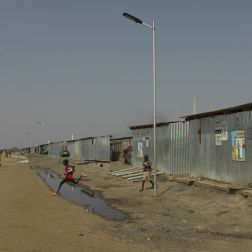- 4 mins read time
- Published: 11th January 2013
Haiti: three earthquake commemorations, three steps in reconstruction
On January 12th, 2010, a devastating earthquake struck Haiti. People across the island of Ireland made an incredible response to our emergency appeal, raising €1.1 million. Thanks to the generosity and solidarity of supporters like you, a lot of tangible progress has been made. However major challenges remain to rebuild Haiti. Three years on, hundreds of thousands of Haitians are still living under tents and tarpaulins with very limited access to basic services, such as sanitation, health care and education.
Urban planner Agathe Nougaret has been living and working in Haiti since December 2010. She joined Oxfam as an Urban Coordinator in August 2012. Here, she writes about finding hope as the third anniversary of the earthquake approaches.
I can’t believe it’s been three years already since the earthquake hit in January 2010. I wasn’t in Haiti for “le 12” (“the 12th” a local term to refer to the earthquake), I didn’t witness the mayhem and great solidarity with my own eyes. I arrived months after, when the reconstruction process was supposed to kick-off, once rescue teams and emergency settlement professionals had done their job.

CAPTIONS: Top-Left: “Buying drinkable water every day was not that easy for people in the neighbourhood. This is one more reason to value the Oxfam intervention,” says Andson Fils-Aimé, who helped build this protected spring-fed water-collection point in the Merger area. Photo: Anna Fawcus / Oxfam. Top-Right: A broken landmark in Croix-Desprez, Port-au-Prince. Photo: Agathe Nougaret/Oxfam. Bottom-left: This mountain of waste in Croix-Desprez, Port-au-Prince, is a daunting task for 2013. Agathe Nougaret/Oxfam Bottom-Right: Yvon Neptune (58): “I moved here in 2009, so I can tell what the difference is since Oxfam did the water captage and canalisation, and started its sensitisation campaign in 2011. This is the answer to the cholera threat and also to other waterborne diseases and malaria.”
January, 12th, 2011
I spent the first anniversary of the earthquake on the steps of the destroyed cathedral, in downtown Port-au-Prince. In the middle of a political crisis, Haitians had stopped burning tyres to ask for their vote to be accounted for. Everyone gathered in front of this symbol of despair, dressed in white, screaming his or her pain. I was so overwhelmed that I didn’t prepare for the questions. As a foreigner, many people came to me to ask why the international community was not rebuilding homes for the victims and stopping the cholera outbreak. I did my best to explain that the scale of the disaster took everyone aback, and setting up temporary settlements, camps in other words, was a complicated and tedious task. “There are less cholera victims in camps than anywhere else thanks to NGO efforts”, I said, but my voice got lost in the fervent religious clamour. What could I say, how could I justify the stalemate Haiti experienced? No available land, no government... I didn’t have words of comfort for the people suffering around me.
January 12th, 2012
Last year, I went to the Port-au-Prince cemetery for the second anniversary of the earthquake. There I met cemetery employees who had to deal with thousands of bodies days after the earthquake. Their stories sent shivers down my spine. Next to the 01/12 memorial sculpture newly built in the cemetery, I met a poet and a painter who explained to me how art helped them to cope with the trauma. They were hopeful, though. So much rubble had been cleared in the past year. The new president promised to take action for what really matters, education of Haitian kids. NGOs were starting to repair homes and even build permanent houses. Over the Christmas holiday, the camp in front of my office had been cleared by the Haitian government through a relocation programme run by international agencies. I was personally involved in this great movement, and I was proud. These first little steps were the hardest to take, as we were paving the way for an important scale-up in relocation and reconstruction efforts.
January 12th, 2013
I haven’t decided where I’ll spend the anniversary yet. I want to be somewhere significant, where I feel part of the Haitian community. I think I’ll choose the Villa Rosa slum, where I completed a NGO project last June, repairing and building 600 permanent homes. I don’t want to join the choir of critics who state that big land-owners will never help us rebuild the country, that the Government doesn’t have the means to do its job, that 358,000 people still live in camps. They might be right, but I want to celebrate our successes, this year. We have found ways to involve the community in planning, rebuilding and managing their neighbourhoods, and we’ve helped the government to see slums as a challenge, not as a threat. We’re working hard to convince donors to let us replicate this first set of pilot projects. The task was so daunting three years ago, but slowly, we’re getting there. That’s what I want to remember on January 12th.




